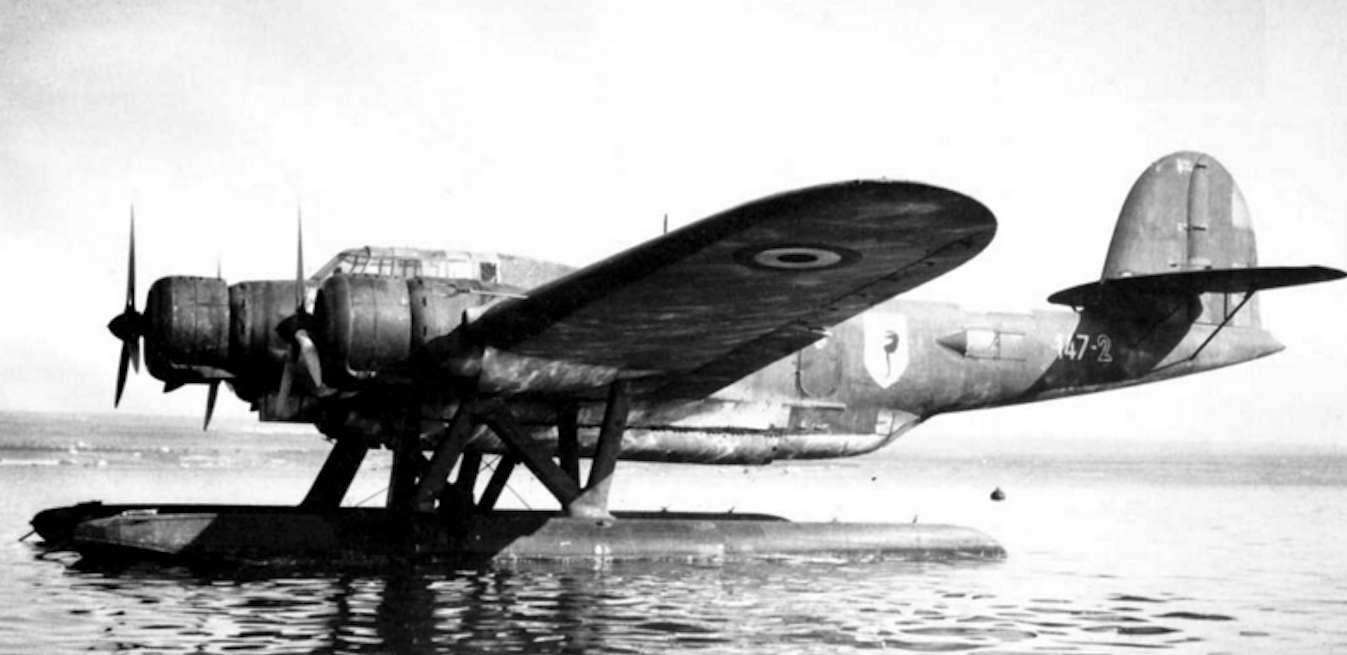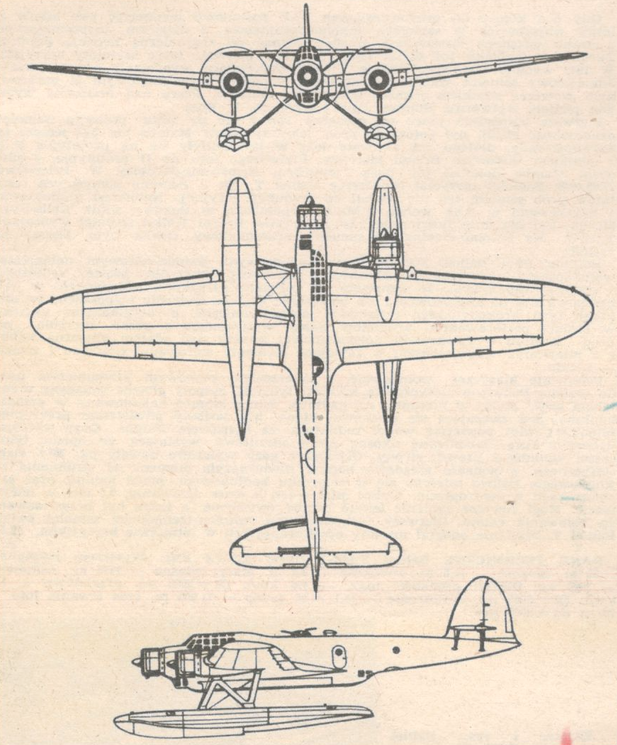Kraków 2020-03-25
00139b Section 1939
CANT Z-506 B Airone
Poland
Torpedo bomber seaplane
History
The pre-war plan for the expansion of the Polish Maritime Forces provided for the creation of a squadron of torpedo-bomber planes in 1938-1939. The squadron was to be based in the newly built naval aviation base in Hel. The Polish aviation industry tried to develop maritime versions of Żubr (LWS-5 A) and Lublin R-XX aircraft for the role of torpedo-bomber aircraft. However, time was needed for these planes to succeed. That’s why the Navy was looking for a suitable plane abroad.
Among several proposals, the Italian CANT Z-506 B Airone 506 B seaplane was selected. The word "Airone" means Heron. The CANT Z-506 B Airone aircraft was much better than the proposed Dutch Fokker T.VIII aircraft. The contract with Italy was risky, but successful previous purchases in Italy encouraged to take risks.
In October 1937, the Italian Cantieri Riuniti dell Adriatiko plant on the bay of Monfalcone near Trieste, submitted an offer for the supply of CANT Z-506 B Airone seaplanes to Poland. The negotiations of the Chief Inspectorate of the Armed Forces with the Italian company were conducted from December 1937. Poland planned to buy 16 aircraft. The Italians ordered payment for 6 aircraft in advance. The price for one aircraft was set at 23,000 pounds sterling (PLN 780,000). The contract was signed in July 1938. The batch of 6 CANT Z-506 B Airone aircraft was to be ready for collection at the turn of June and July 1939.
Radio equipment and bomb ejectors were to be manufactured by the Polish company Świątecki. Bombs and torpedoes were also to be of Polish production. The weapons were also to include rifles with ammunition and torpedoes of the Italian company Breda SAFAT. The plane was to receive a modern radiopelenger.
Seaplane CANT Z-506
The CANT Z-506 aircraft was designed as a two-float transport seaplane, which is powered by three engines. Initially, 455 kW (610 hp) Piaggio Stella IX engines were used. The plane took on board up to 14 passengers. The CANT Z-506 aircraft entered production in 1936. Alfa Romeo 126 RC.34 engines with 560 kW (750 HP) were introduced into the drive. The military version of CANT Z.506 has a crew of five. The aircraft was produced in the factories "Cantieri Riuniti dell ‘Adriatico" in Monfalcone and "Cantiere Navale Triestino" in Finale Ligure (CRDA CANT). The aircraft quickly became very popular and in demand. That is why its production was also started at Piaggio. The total aircraft production was 320 aircraft. CANT Z-506 aircraft were in service until 1959.
In 1936–1938, the CANT Z-506 set a number of altitude, speed and distance records for its class. Records: speed of 308.25 km / h (191.539 miles per hour) over a distance of 5,000 km (3,107 miles). Speed 319.78 km / h (198.7 miles per hour) over a distance of 2,000 km (1,243 miles). Speed 322.06 km / h (200,118 miles per hour) per 1,000 km (621 miles).
Seaplane CANT Z-506 B Airone in Poland
In June 1939, Navy captain Eugene Podolski and engineer Janusz Lange tested the first CANT Z-506 B Airone aircraft for Poland. Strange things happened in Italy. There were burglaries into the chest with the Polish radio operator. Many things were not delivered on time. During the first flight, at right height of 2,000 m, the right engine interrupted. The pilot landed successfully and the reason for the failure was a broken connecting rod.
At that time a second crew arrived from Poland. Unfortunately the other plane was not ready to fly. Due to the bad political situation, both crews returned to Poland with the only CANT Z-506 B Airone aircraft capable of flying. International regulations required that aircraft in flight could not be armed. Therefore, machine guns had to be dismantled. The armament was to be sent by sea, but it never reached Poland. Some say that the Italians did not send the cargo, others that it was taken over by the German army in the port of Gdansk.
Polish CANT Z-506 B Airone took off from Italy on August 27, 1939. On board was a radiotelegraphist Władysław Wzorek, who contributed well to safe passage. The Polish crew was helped by controllers from Budapest who gave the safest route over the already occupied Slovakia. Immediately after landing, the aircraft was entered into the status of the Marine Aviation Squadron.
On September 1, 1939, the CANT Z-506 B Airone aircraft successfully survived the German bombing at the Naval Aviation Squadron base in Puck.
At night, September 1-2, 1939, the CANT Z-506 B Airone aircraft was sent to Lublin for armament. The crew was headed by naval captain pilot Roman Borowiec. The flight was very dramatic. There was fog. The plane has not been refueled since the start from Italy. The crew was running out of fuel. The crew even planned to leave the plane on parachutes. Fortunately, the plane landed on the Vistula near Kozienice. After two days, the plane was refueled and on September 4, 1939, the plane launched on Lake Siemień near Parczew. There was a temporary base of the Naval Aviation Squadron on the island of Zielony Grąd. The aircraft was masked and waiting for its armament, which was to be delivered by the Lublin factory. However, German bomber tracked down the plane and fired at and bombed. It is possible that the aircraft base was revealed to the German army by Folksdojcza. The CANT Z-506 B Airone aircraft burned down on September 11, 1939. The remains of the plane were still sticking out of the water, because it was only 1.5 m deep.
The other five CANT Z-506 B Airone aircraft were taken over by the Italian army. The planes were already paid by Poland.
Written by Karol Placha Hetman
Kraków 2020-03-25
00139b Section 1939
CANT Z-506 B Airone
Poland
Torpedo bomber seaplane
Construction
The CANT Z-506 aircraft was designed as a two-float transport seaplane, which is powered by three star engines.
Wings
The wooden structure has three girders. The wings are covered with plywood.
Fuselage
The wooden hull is covered with plywood. The floats are made of duralumin coated with chitonal and are 12.50 meters long. Each float has six chambers.
Engines
Engines: 3 × Alfa Romeo 126 R.C.34 9-cylinder air-cooled radial piston engines, each 560 kW (750 HP). Propellers: 3-blade propellers with variable pitch.
Armament
Guns:
1 × 12.7 mm (0.50 in) Isotta Fraschini-Scotti machine gun
3 × 7.7 mm (0.303 in) machine guns
Bombs:
1,200 kg (2,645 lb) of general ordnance or
1 × 816 kg (1,800 lb) torpedo
Data T-T CANT Z-506
- Length: 19.24 m (63 ft 1 in)
- Wingspan: 26.5 m (86 ft 11 in)
- Height: 7.45 m (24 ft 5 in)
- Wing area: 86.26 m2 (928.5 sq ft)
- Empty weight: 8,750 kg (19,290 lb)
- Max takeoff weight: 12,705 kg (28,010 lb)
- Powerplant: 3 × Alfa Romeo 126 R.C.34 9-cylinder air-cooled radial piston engines, 560 kW (750 hp) each
- Propellers: 3-bladed variable-pitch propellers
- Maximum speed: 350 km/h (220 mph, 190 kn)
- Cruise speed: 299 km/h (186 mph, 161 kn)
- Range: 1,998 km (1,241 mi, 1,079 nmi) with a 950 kg (2,095 lb) bomb load
- Endurance: 6 hours 26 minutes
- Service ceiling: 7,000 m (23,000 ft)
- Time to altitude: 3,999 m (13,120 ft) in 20 minutes
Written by Karol Placha Hetman
Kraków 2020-03-25
00139b Section 1939
CANT Z-506 B Airone
Poland
Torpedo bomber seaplane
Tally
Poland paid for six CANT Z-506 B Airone aircraft, but received only one. Further supplies were interrupted by World War II.
Written by Karol Placha Hetman


